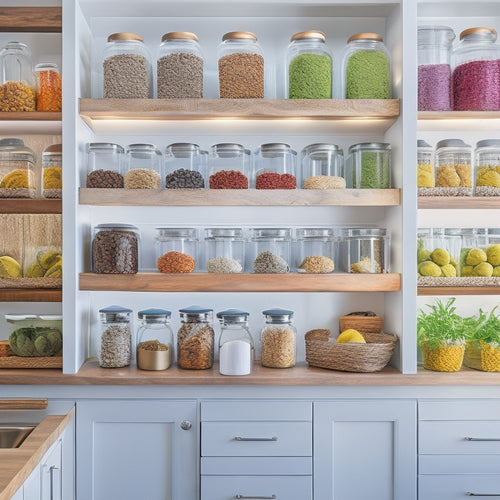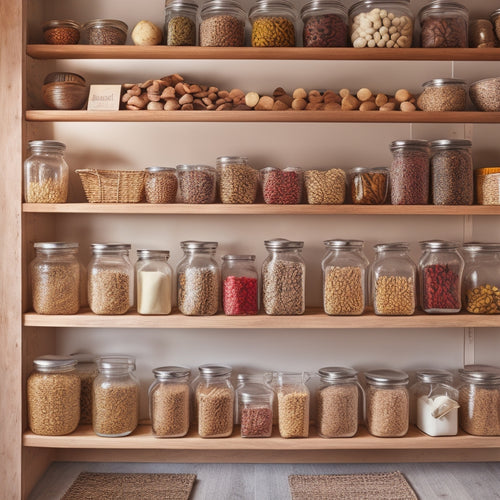
Streamline Kitchen Storage for Diabetes Management Success
Share
You're taking charge of your diabetes management by streamlining your kitchen storage. Start by identifying essential items like meal preparation tools, a food scale, and a kitchen timer. Optimize your cabinet space with shelves, baskets, and dividers to guarantee quick access to supplies. Implement countertop organization strategies like baskets and shelf risers to keep frequently used items within reach. A well-organized kitchen is vital for healthy eating and diabetes management. By implementing these strategies, you'll be better equipped to take charge of your health - and there's even more to explore when it comes to maximizing your kitchen's potential.
Key Takeaways
• A well-organized kitchen with essential diabetes management tools, such as portion control containers and a food scale, promotes healthy eating habits.
• Maximizing cabinet space with shelves, baskets, and dividers helps maintain a clutter-free kitchen and quick access to necessary supplies.
• Labeling and categorization systems, including color coding and shelf dividers, ensure easy identification and retrieval of diabetes management essentials.
• Designating a specific area for medication storage and using storage containers with dividers prevents medication errors and maintains health.
• A well-organized pantry with healthy staples, ingredient rotation, and labeling promotes adherence to a healthy eating plan and reduces waste.
Essential Items for Diabetes Management
When managing diabetes, you need to keep certain necessary items within easy reach to guarantee timely monitoring, treatment, and prevention of complications. A well-stocked kitchen is essential in diabetes management, and it starts with having the right tools and supplies.
For instance, meal prep is an important aspect of managing blood sugar levels. You should have containers and utensils specifically designed for meal prep, such as portion control containers, measuring cups, and spoons. These tools enable you to prepare healthy meals in advance, ensuring you stick to your meal plan.
Portion control is another crucial aspect of diabetes management. Having a food scale and measuring cups helps you measure ingredients accurately, ensuring you're consuming the right amount of carbohydrates, proteins, and fats.
Additionally, a kitchen timer and a thermometer are must-haves for cooking and storing food safely. By keeping these necessary items within easy reach, you'll be better equipped to manage your diabetes and maintain a healthy lifestyle.
Optimizing Cabinet Space Efficiency
Efficiently utilizing your cabinet space is crucial to maintaining a well-organized kitchen, which in turn, helps you quickly access the essential diabetes management tools and supplies you need to stay on top of your condition. By maximizing space, you can store more items in a smaller area, making it easier to find what you need when you need it.
To achieve this, consider installing shelves, baskets, or dividers within your cabinets. These decluttering solutions will help you categorize and prioritize your diabetes management essentials, making sure that they're easily accessible.
Additionally, consider the 'first in, first out' rule when storing supplies like test strips, insulin, and other perishable items. This will ensure that you're using the oldest items first, reducing waste and saving you money in the long run.
Countertop Organization Strategies
You'll also want to implement countertop organization strategies to keep frequently used diabetes management tools, like your glucometer and logbook, within easy reach, freeing up cabinet space for less frequently used items. This will help you quickly access the tools you need, reducing stress and making it easier to manage your diabetes.
Consider incorporating the following countertop organization strategies into your kitchen:
| Strategy | Description |
|---|---|
| Basket Storage | Use baskets or containers to store small items like test strips, lancets, and insulin pens, keeping them organized and visible. |
| Shelf Risers | Elevate frequently used items, like your glucometer and logbook, to create a convenient and accessible station. |
| Wall Hooks | Hang items like your insulin pump or diabetes bag, keeping them off the counter and out of the way, while still being easily accessible. |
Labeling and Categorization Systems
By establishing a clear labeling and categorization system, you can quickly identify and access specific diabetes management supplies, reducing clutter and saving time in your daily routine. This system helps you stay organized, ensuring that essential items are easily accessible when you need them.
To create an effective labeling and categorization system, consider the following strategies:
-
Use color coding to differentiate between categories, such as supplies for blood glucose monitoring, insulin administration, and meal planning.
-
Implement container organization by grouping similar items together in labeled bins or baskets.
-
Utilize shelf dividers to separate supplies on shelves, making it easier to find what you need.
- Incorporate drawer inserts to maximize storage space and keep supplies organized.
Smart Storage for Medications
As you've organized your diabetes management supplies, it's now important to turn your attention to smart storage solutions for your medications, making certain they're safely stored and easily accessible when needed.
Proper medication organization is vital to maintaining your health and preventing medication errors. Start by designating a specific area in your kitchen for medication storage, such as a cabinet or drawer. Consider investing in a medication organizer or storage container that can hold all your medications, supplies, and instructions. This will keep everything in one place and make it easier to find what you need quickly.
Look for storage solutions with dividers or compartments to separate different medications and dosages. Additionally, make sure the storage area is cool, dry, and out of direct sunlight to preserve the potency of your medications.
Refrigerator and Freezer Tips
When managing diabetes, it's important to store insulin and other temperature-sensitive medications in the refrigerator at a consistent temperature between 39°F and 46°F to maintain their potency. Proper storage in the refrigerator and freezer is vital for maintaining the effectiveness of your diabetes management plan.
To optimize your refrigerator and freezer space, consider the following tips:
-
Use space-saving solutions like adjustable shelves, baskets, or bins to keep medications and supplies organized and easily accessible.
-
Implement organization hacks like labeling and categorizing your contents to make sure you can quickly find what you need.
-
Prioritize freshness maintenance by storing perishable items like insulin and medications in the coldest part of the refrigerator, usually the bottom shelf.
- Design an efficient layout by grouping similar items together and keeping frequently used items in easy-to-reach locations.
Pantry Organization for Healthy Eating
You can greatly impact your diabetes management by stocking your pantry with healthy staples and organizing them in a way that promotes smart food choices. A well-stocked pantry is essential for meal prep, allowing you to plan and prepare healthy meals in advance.
Start by purging your pantry of unhealthy items and restocking with whole grains, canned beans, and low-sugar snacks. Organize your pantry into categories, such as baking supplies, grains, and snacks, to make it easy to find what you need. Implement an ingredient rotation system to make sure that older items are used before they expire.
Label each item with the date it was purchased or opened, and store them in a 'first in, first out' order. By doing so, you'll reduce food waste and save time when meal prepping. With a well-organized pantry, you'll be more likely to adhere to your healthy eating plan, making it simpler to manage your diabetes.
Adapting to Changing Dietary Needs
Your dietary needs may shift over time, necessitating adjustments to your kitchen storage and meal planning strategies. As you navigate diabetes management, maintaining flexibility and adapting to changing nutritional requirements is crucial. This may involve tweaking your pantry staples, cooking techniques, and meal planning approaches.
To guarantee a smooth shift, consider the following:
-
Reassess your pantry: Remove or substitute ingredients that no longer align with your dietary needs, and restock with healthier alternatives.
-
Explore ingredient substitution: Learn to swap high-carb or high-fat ingredients with healthier options, such as replacing white flour with almond flour or using coconut oil in place of butter.
-
Update your meal planning: Modify your meal planning strategies to accommodate new dietary restrictions or preferences, ensuring you're fulfilling your nutritional needs.
- Stay organized: Maintain an orderly kitchen and structured meal planning system to reduce stress and facilitate seamless meal preparation.
Frequently Asked Questions
How Do I Declutter My Kitchen Without Wasting Diabetes Supplies?
'As you start on this medieval quest for a clutter-free kitchen, remember to separate diabetes essentials from non-essentials, then organize supplies in an efficient storage system, minimizing waste and ensuring seamless diabetes management.'
Can I Use a Kitchen Cart for Additional Storage and Counter Space?
You can maximize your kitchen's functionality by incorporating a kitchen cart, which provides additional storage and counter space, allowing you to efficiently organize essentials and create a more streamlined cooking environment.
How Often Should I Clean and Sanitize My Kitchen Storage Containers?
You should clean and sanitize your kitchen storage containers at least once a week to maintain proper storage maintenance and guarantee container hygiene, as dirty containers can harbor bacteria and contaminate food.
Are There Any Specific Kitchen Storage Solutions for Insulin Pump Users?
When you're living with an insulin pump, you'll appreciate storage solutions that keep accessories organized and within reach, offering convenience and peace of mind, such as pouches, cases, and clips designed specifically for your needs.
Can I Involve My Family in Organizing My Diabetes Kitchen Storage?
You can definitely involve your family in organizing your diabetes kitchen storage! Encourage their input on decluttering and categorizing supplies, and assign tasks to make them feel invested in your organization process.
Related Posts
-

Rustic Hanging Racks for Country-Style Kitchens
Rustic hanging racks are a game changer for your country-style kitchen, blending functionality with charm. They maxim...
-

Innovative Lazy Susan Storage Solutions
Innovative Lazy Susan storage solutions are a revolutionary advancement for any space, especially in kitchens. They m...
-

Innovative Pantry Storage Ideas for Homes
Revamp your pantry into an efficient space with innovative storage solutions. Use vertical storage options like ceili...


